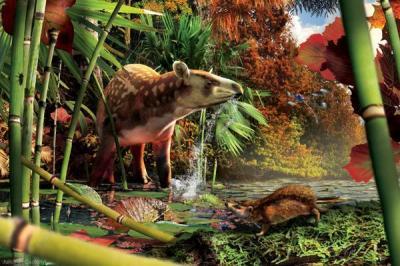Meet perhaps the tiniest hedgehog species ever: Silvacola acares. Its roughly 52-million-year-old fossil remains were recently identified by a University of Colorado Boulder-led team working in British Columbia.
The hedgehog's scientific name means "tiny forest dweller," said CU-Boulder Associate Professor Jaelyn Eberle of the geological sciences department, lead author on the study. The creature -- a new genus and species to science -- was only about 2 inches long, roughly the length of an adult thumb.
"It is quite tiny and comparable in size to some of today's shrews," Eberle said. She speculated Silvacola may have fed on insects, plants and perhaps seeds. Did it have quills like contemporary hedgehogs? "We can't say for sure," Eberle said. "But there are ancestral hedgehogs living in Europe about the same time that had bristly hair covering them, so it is plausible Silvacola did too."
Hedgehogs have become quite the rage as pets in North America in the past several years. The most common hedgehog pet today is the African pygmy hedgehog, which is up to four times the length of the diminutive Silvacola.
The fossils of the hedgehog, along with fossils of a tapir-like mammal about the size of a medium-sized dog, were found in north-central British Columbia at a site known as Driftwood Canyon Provincial Park that likely was a rainforest environment during the Early Eocene Epoch about 52 million years ago, she said.
While the Earth has experienced many dramatic changes in climate since the dinosaurs died out 66 million years ago, the Early Eocene was one of the warmest periods on Earth since the extinction. During this interval -- about 53 million to 50 million years ago -- North American mammal communities were quite distinct from those of today, said Eberle.
A paper on the discovery of the ancient hedgehog and tapir is being published today in the Journal of Vertebrate Paleontology. Study co-authors include Research Scientist Natalia Rybczynski of the Canadian Museum of Nature in Ottawa, Ontario, and Professor David Greenwood of Brandon University in Brandon, Manitoba. The fieldwork was supported by the Natural Sciences and Engineering Research Council of Canada.

A new study led by the University of Colorado Boulder describes the fossils of a tiny hedgehog previously unknown to science living in a British Columbia rainforest some 50 million years ago near the height of a global warming stretch during the early Eocene Epoch. The researchers also found fossils of an ancient relative of modern tapirs known as Heptodon, which resembles a small rhino with no horn and a short trunk.
(Photo Credit: Julius Csotonyi)
"Within Canada, the only other fossil localities yielding mammals of similar age are from the Arctic, so these fossils from British Columbia help fill a significant geographic gap," said Rybczynski. Other fossils of the same age have previously been discovered in Wyoming and Colorado, she said.
Instead of being removed from the surrounding rock, the delicate upper dentition of the tiny hedgehog was scanned with an industrial, high-resolution CT scanner at Penn State University so it could be studied without risking damage to its tiny teeth. Modern hedgehogs and their relatives are restricted to Europe, Asia and Africa.
The other mammal discovered at the site, Heptodon, is an ancient relative of modern tapirs, which resemble small rhinos with no horns and a short, mobile trunk or proboscis, said Eberle, also curator for vertebrate paleontology at the University of Colorado Museum of Nature and Science.
"Heptodon was about half the size of today's tapirs, and it lacked the short trunk that occurs on later species and their living cousins," said Eberle. "Based upon its teeth, it was probably a leaf-eater, which fits nicely with the rainforest environment indicated by the fossil plants at the site."
Most of the fossil-bearing rocks at Driftwood Canyon were formed on the bottom of an ancient lake and are well-known for their exceptionally well-preserved leaves, insects, and fishes. But no fossils of mammals had ever before been identified at the site.
"The discovery in northern British Columbia of an early cousin to tapirs is intriguing because today's tapirs live in the tropics," said Eberle. "Its occurrence, alongside a diversity of fossil plants that indicates a rainforest, supports an idea put forward by others that tapirs and their extinct kin are good indicators of dense forests and high precipitation."
Fossil plants from the site indicate the area seldom experienced freezing temperatures and probably had a climate similar to that of contemporary Portland, Ore., roughly 700 miles to the south.
"Driftwood Canyon is a window into a lost world, an evolutionary experiment where palms grew beneath spruce trees and the insects included a mixture of Canadian and Australian species. Discovering mammals allows us to paint a more complete picture of this lost world," said Greenwood.
"The early Eocene is a time in the geological past that helps us understand how present-day Canada came to have the temperate plants and animals it has today," Greenwood said. "However, it can also help us understand how the world may change as the global climate continues to warm."